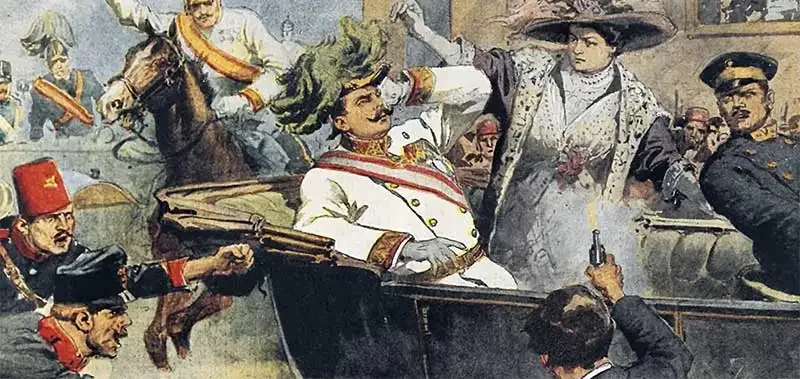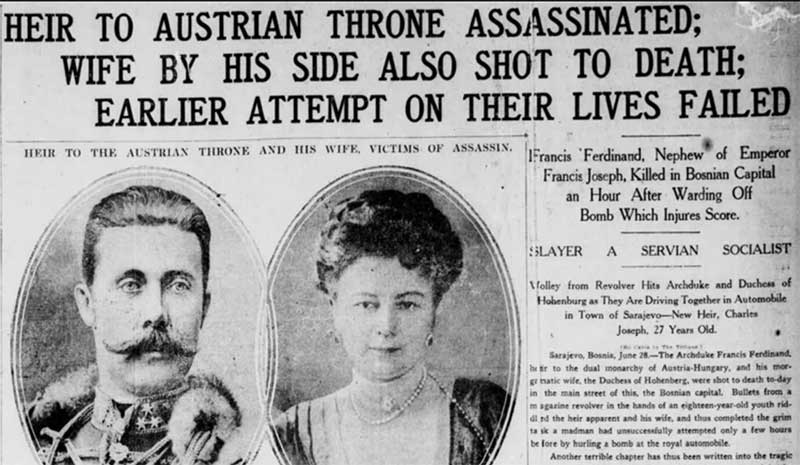- Military Myths, Mysteries, Legends & Curiosities
- Who Killed the Archduke? (28th June 1914)

Who Killed the Archduke? (28th June 1914) One of the greatest mysteries of the First World War
One of the greatest mysteries of the First World War concerns its outbreak. The great states of Europe - Britain, France and Russia on one side against Germany and Austria-Hungary on the other - declared war against each other between 28 July and 4 August 1914.
Officially, the reasons for the outbreak of war were the demands that Austria-Hungary put on the Kingdom of Serbia after a Serb murdered Archduke Franz Ferdinand, heir to the Austrian throne in Sarajevo on 28 June. Tensions had been building between the great powers and between Austria-Hungary and Serbia in particular, for some months. The commonly accepted version of events is that the murder in Sarajevo was the spark that inadvertently set off a chain of events that brought all the great powers to the fields of war.
But even at the time, not everyone accepted this version of events. When war broke out, the mystery of what had actually happened was forgotten in the rush to war and the insistent demands of armies in battle. But the questions being raised in July 1914 have never really been answered and the mystery remains.
The fact is that Archduke Franz Ferdinand was not a popular man at the Hapsburg court, nor in the corridors of power of the Austrian government. He was arrogant, convinced he was right about everything, intolerant of opinions he did not like and - which made things worse - not very clever. The senior bureaucrats in the Austro-Hungarian Empire dreaded the day when he would become Emperor. And that day was not far off. Emperor Franz Joseph had sat on the throne since 1848. He was old, sick, and clearly not long for this world. And he had fallen out badly with his nephew Franz Ferdinand.
The event that made the two men fall out came in 1896, when Franz Ferdinand, then aged just 21, announced that he wanted to marry Countess Sophie Chotek. The Countess was young, pretty and intelligent and came from a family that had been of noble blood in Bohemia for at least the past 600 years. But that was not good enough for Franz Joseph. He declared that his nephew had to marry a royal princess. What the young man did for leisure was of little concern. He could have all the girlfriends he wanted, but he had to marry a princess.
Young Franz Ferdinand refused. He wanted to marry Sophie, and that was that. In the end the Emperor allowed the marriage to go ahead, but on the humiliating terms that Franz Ferdinand's wife would be denied the title of Archduchess, retaining her own rank, and that her children were barred from inheriting the throne. Whenever a court event demanded that Franz Ferdinand attend, he was put on the top table, his wife consigned to a side aisle. It was humiliating, and the younger couple grew bitter. They detested the bureaucrats and nobles close to the old emperor. Franz Ferdinand made no secret of the fact he would sack the lot as soon as he came to power.
Politically, Franz Ferdinad was a direct threat to the policies being followed by the government in Vienna. Traditionally, the Hapsburgs had ruled their vast domains through a diffused system. The Emperor of Austria was also the Duke of Dalmatia, but Dalmatia had its own government - as did more than a dozen other states ruled by the elder Emperor. For some 30 years, there had been a slow but determined drive to unify the Empire into a single, monolithic state. Franz Joseph supported the changes, but Franz Ferdinand did not.
Both men recognized that the changes alienated some of the Empire's citizens and alarmed smaller countries on the Empire's borders - of which the Kingdom of Serbia was one. They differed over how to deal with the situation. Franz Ferdinand wanted to go back to the dispersed system of government. Franz Joseph put in place strict security systems to crack down on dissent and bully smaller states into silence.
In 1908, the small state of Bosnia had its nominal independence stripped away, and it was subsequently ruled direct from Vienna. The largely Serb population of Bosnia resented the move. The Kingdom of Serbia feared it would be next.
Various groups were formed to campaign for Serb freedoms, Serb culture and Serb power. Most were peaceful, but one was dedicated to violence. The Black Hand was made up of serving or former members of the Serb Army. They undertook terrorist attacks on Austrian government posts in Bosnia.
In May 1914, it was announced that Franz Ferdinand would visit Sarajevo, capital of Bosnia, on 28 June, to undertake assorted ceremonial duties. The Black Hand decided to kill him. Not long afterwards, rumors began to circulate in Vienna that the heir to the throne would not be coming back from Sarajevo - there would be an accident of some kind. That would clear the way for Archdule Karl, a grandnephew of Emperor, to become heir to the throne. Karl was a jovial figure who shared the views and policies of the Austrian government. And he had married an Italian princess.
It has never been explained why Archduke Franz Ferdinand's trip to Sarajevo went ahead when it did. There was nothing urgent that he had to attend to, merely some routine ceremonial duties. When he got there, Franz Ferdinand found that the military escort that he had expected was not there. Even worse, the three special police officers assigned as bodyguards were separated from him by a local police officer and left in a waiting room at the railway station.
Meanwhile, Franz Ferdinand and Sophie were driving in an open car through the city streets. As they passed a bridge, a member of the Black Hand named Nedeljko Cabrinovic threw a hand-grenade. It bounced off the car and exploded in the road. About 20 people were injured, but the Archduke and his wife were uninjured. As his visit ended, Franz Ferdinand could still not find his bodyguards. He decided to avoid the planned route - fearing more assassins attempts - and instead told the driver to stick to the main roads and head straight to the station. The driver did no such thing. Claiming that he "got lost" the driver went straight back to the scene of the earlier attack. There, another Black Hand man, Gavrilo Princip, was waiting. He lunged forward and shot both Franz Ferdinand and Sophie.
Despite swift medical attention, both victims died within the hour.

The Austrian police arrested both Cabrinovic and Princip, put on trial, convicted of murder and sentenced to 20 years in prison. Cabrinovic promptly vanished. The Austrian authorities later claimed that he had died in prison of tuberculosis and been hurriedly buried in a secret grave. By that time, a rumor was circulating in Serbia that Cabrinovic had been an Austrian agent all along. Several members of the Black Hand had apparently harbored suspicions about him from the moment he had volunteered in 1912. It was alleged that he had not died in prison, but had been released with a new identity and the pay for his work.
Meanwhile, the Austrian government had got exactly what it wanted. Franz Ferdinand was no longer going to be Emperor, the much more amenable Karl was heading for the throne instead. Just as important, Austria-Hungary had a perfect excuse to engineer a war against Serbia. Which is exactly what they did.
- Austro-Hungarian Empire (1867-1918)
- Bosnia and Herzegovina (1878-1918)
- {{#owner}}
- {{#url}} {{#avatarSrc}}
{{name}} {{/url}} {{^url}} {{#avatar}} {{& avatar}} {{/avatar}} {{name}} {{/url}} - {{/owner}} {{#created}}
- {{created}} {{/created}}























